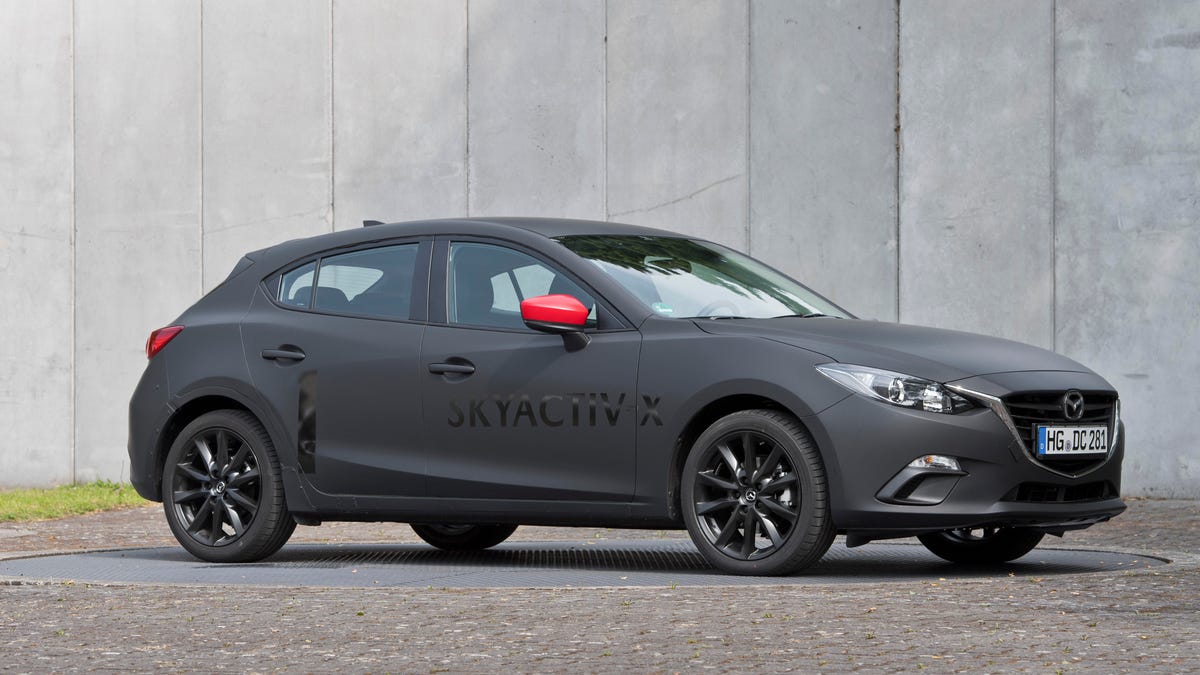Mazda previews its next-gen technologies for 2020 and beyond
Want to know everything cool that Mazda's working on for the next three or four years? We got a peek at the automaker's technology road map for the future.

We already had some idea of how Mazda's upcoming Skyactiv-X engine technology works. Now, we have a clearer picture of how well it works and what kind of car it could live in, as new details have been unveiled about the new engine technology and the automaker's next-generation vehicle platform.
Skyactiv-X engine tech
For those needing a quick refresher, the Skyactiv-X technology works by making a gasoline engine operate something like a diesel engine under certain conditions. At low engine speeds, traditional gas combustion is used, igniting the air-fuel mixture with spark plugs in the combustion chamber. As the revs climb, Skyactiv-X switches off the plugs and relies solely on the high pressure in the combustion chamber to ignite the gasoline without the need for a spark. This is what Mazda's engineers refer to as homogenous charge compression ignition (HCCI) and it's the source of Skyactiv-X's improvements. You can learn more about it at the link above.
Beneath that shroud is the next generation of Mazda engine tech. Skyactiv-X is a gasoline engine that acts like a diesel.
Recently, Mazda invited journalists to test the new Skyactiv-X prototype vehicles on the road at an event in Germany where the automaker's claims of 20 to 30 percent efficiency improvement compared to the current Skyactiv-G gas engine was put to the test. Drivers averaged a 14.1 percent improvement (about 37.2 mpg) when equipped with the automatic transmission and a 13.6 percent gain (34.6 mpg) for the manually shifted mules compared to Mazda's projections for its current engine technology.
Auto-journos tend to drive with a bit more "zest" than your average motorist, so it's no surprise that the tested numbers are a bit lower than Mazda's projections. Still, these early results show promise.
Next-generation vehicle platform
Mazda also detailed Improvements for its next-generation vehicle platform which affects everything from the tires to the seats in pursuit of that feeling of "Jinba-ittai" or zoom-zoom that is the brand's hallmark.
It starts at the ground where the new platform doesn't just tweak the suspension and dampers, but also the wheels and tires to improve the way these parts work harmoniously to control the ride, absorb bumps and smooth out the transfer of energy into the body of the car. Everything from the rigidity of the suspension mounts to the stiffness of the tire's sidewalls comes into play with the goal of tuning out harshness while retaining a "connected" feeling in the ride and steering.
The new platform should feature the usual improvements stiffness, but also places an emphasis on connecting the driver to the car and to the road.
Above the suspension, the body itself gets stiffer due to the use of integrated ring structures that improve chassis rigidity, but also more evenly distribute inputs from the suspension throughout the structure of the vehicle. Basically a solid body allows the suspension to react more predictably and responsively, and Mazda claims it's firmed things up without adding much weight.
The automaker has even rethought the seat, which is the biggest connection point between the driver and the car. Mazda's engineers have adjusted how the new bucket aligns the driver's pelvis and spine when seated in a more natural position. The claimed result is better seat of the pants feel while also reducing fatigue. Considering the automaker's obsessive attention to ergonomics and steering wheel and pedal placement on its other vehicles, I'm looking forward to getting my butt in that new seat.
The big picture for this next-generation vehicle platform is a more controlled ride that should still offer really good "feel" and feedback to an engaged driver and a more direct connection between that driver and their car.
2020 and beyond
Mazda's road map has the new vehicle platform and Skyactiv-X engine technology slated to arrive in 2019. We expect to learn more about the production version of these technologies and a new generation of Mazda's Kodo design language over the next few months. 2019 is also when we can expect a major revision to the Mazda Connect dashboard tech. Presumably, all of these revisions will hit the road together in the next-generation Mazda3.
The Skyactiv-X test mules preview improvements that we should see in the road in 2019 in the next generation Mazda3.
The road doesn't end there. Mazda also has plans to electrify its lineup with a 2019 launch of a mild hybrid model and a battery electric vehicle. A plug-in hybrid model will follow some time later.
Additionally, the automaker has a 2020 target to begin testing its Co-Pilot autonomous technology. Mazda describes Co-Pilot as "human-centered" which leads me to believe that this is more driver aid tech rather than a self-driving car, but we don't have many details beyond the testing target. Mazda's still keeping a few cards close to its vest.

